Easy Homemade Spaghetti Sauce Recipe
This homemade spaghetti sauce is about to become your kitchen’s secret weapon – the kind of recipe that makes people think you’ve been hiding culinary skills all along.
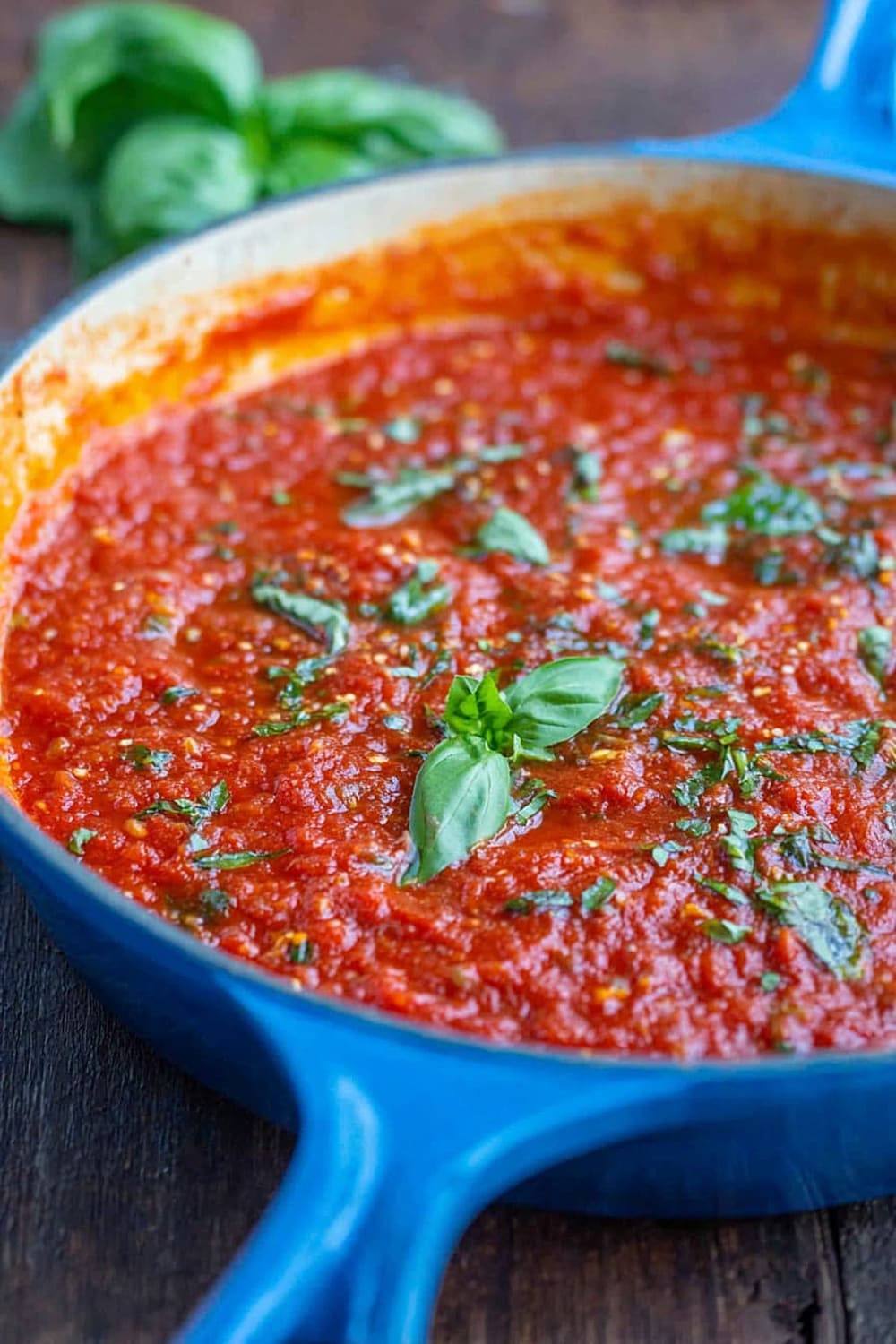
One whiff of this simmering on your stovetop and your whole house transforms into an Italian grandmother’s kitchen, complete with that magical aroma that makes everyone suddenly appear asking “when’s dinner?”
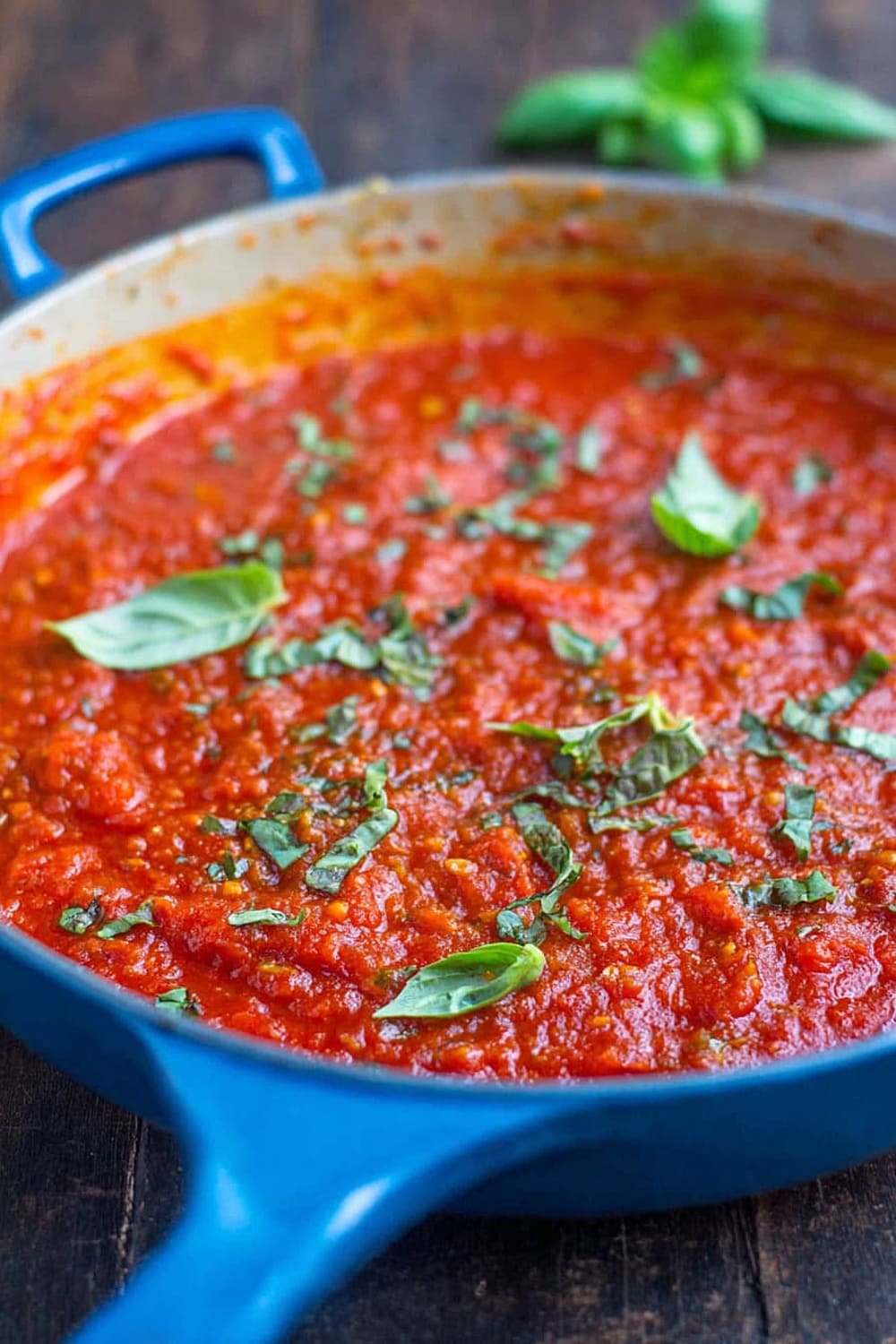
The beauty lies in how this sauce achieves restaurant-quality depth using ingredients you probably already have lurking in your pantry, proving that impressive doesn’t have to mean complicated.
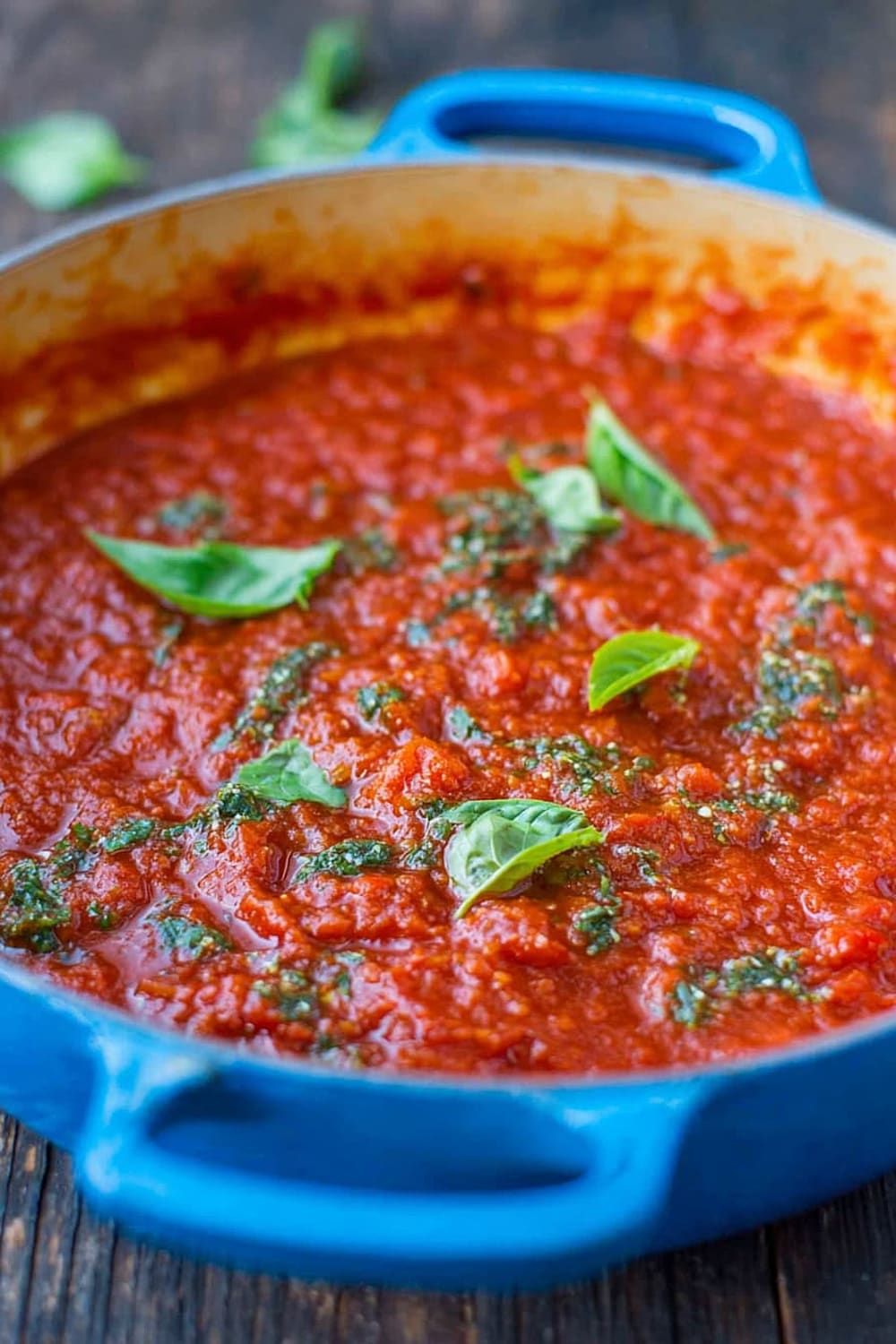
Those finely grated carrots are the game-changer here – they melt into the sauce creating natural sweetness and richness that’ll have people guessing your “secret ingredient” for years.
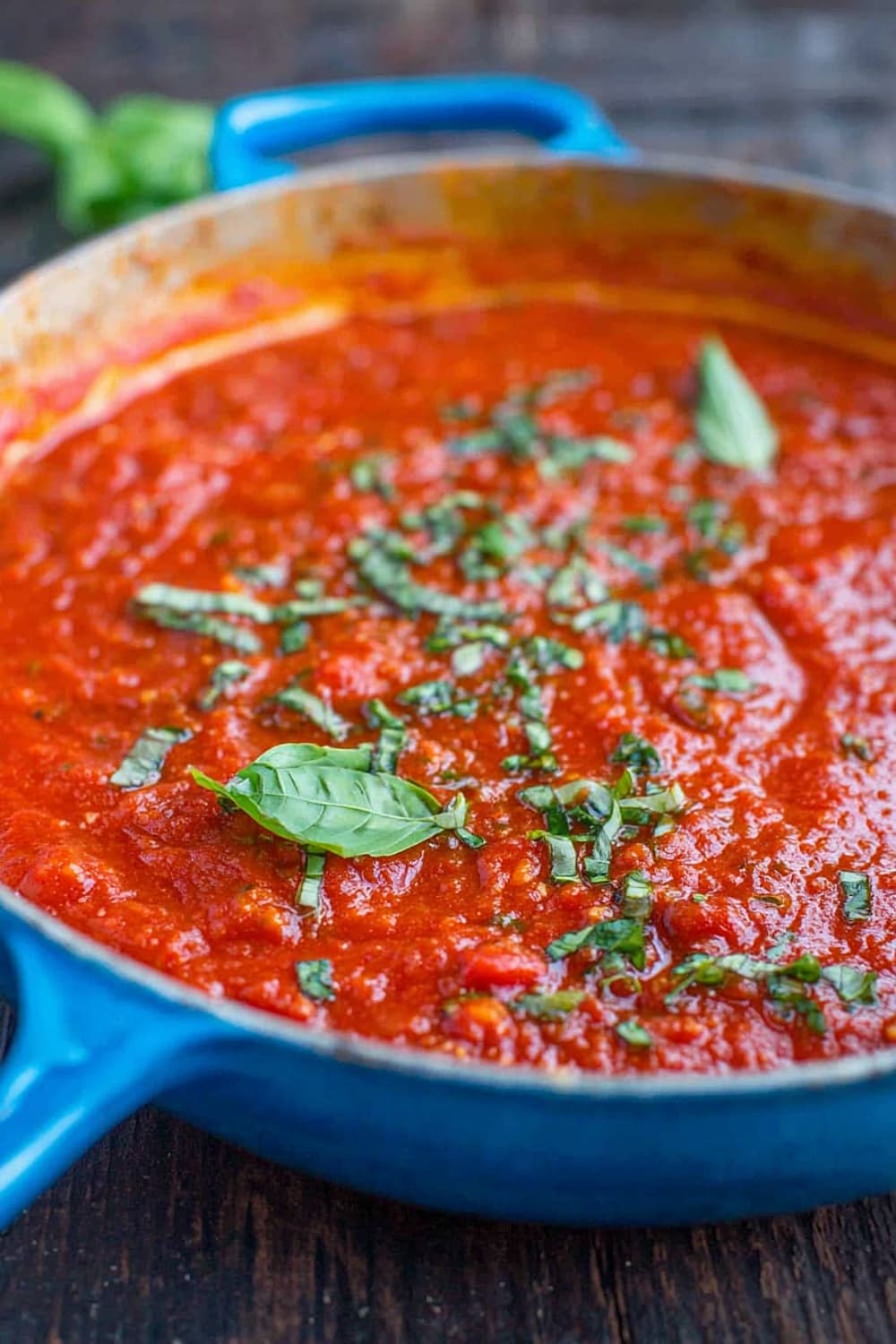
Fresh herbs make all the difference, turning what could be just another tomato sauce into something that tastes like it’s been simmering in a Italian nonna’s kitchen for hours.
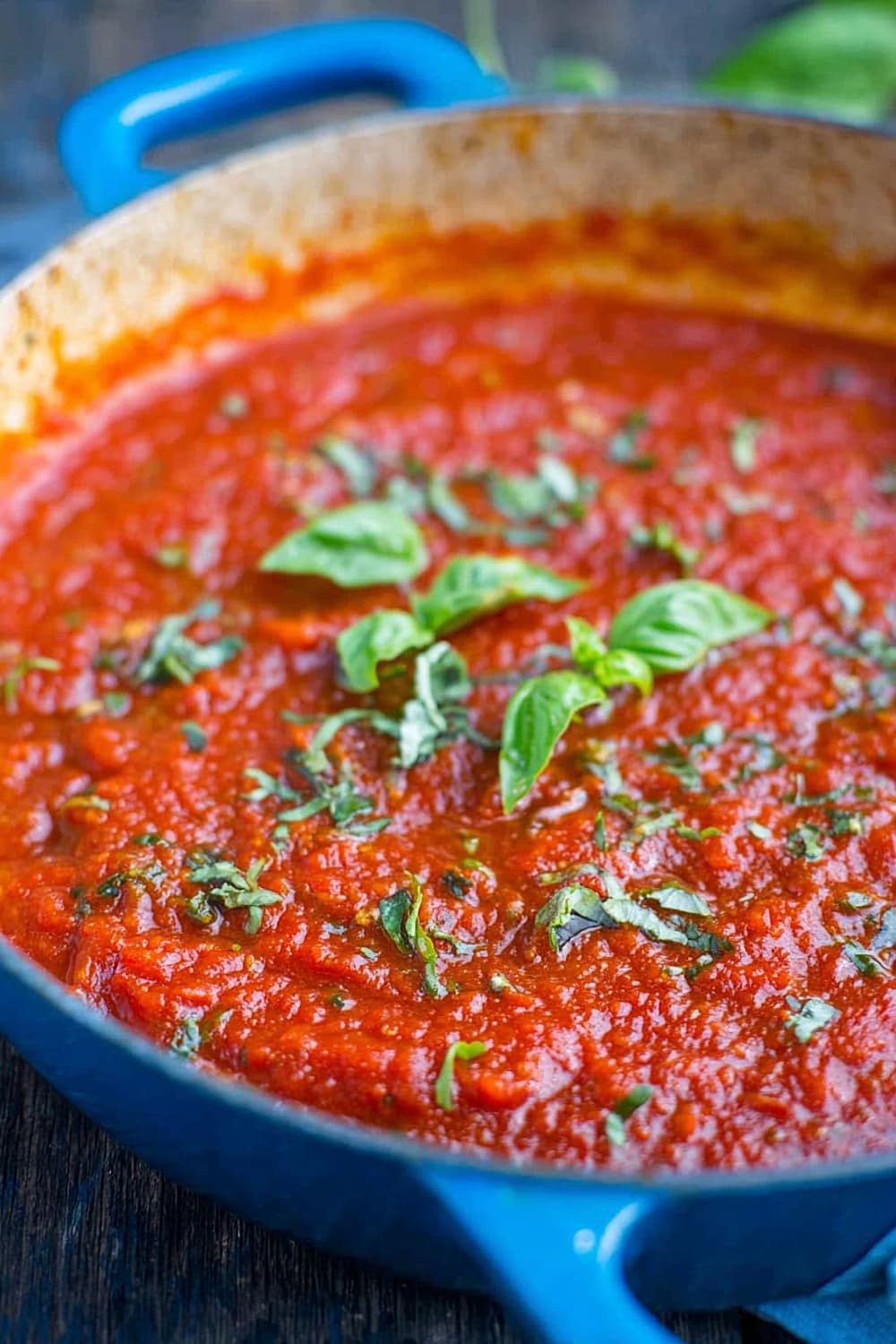
Once you taste how much better homemade beats store-bought, those jarred sauces are going to start looking pretty sad sitting on the shelf.
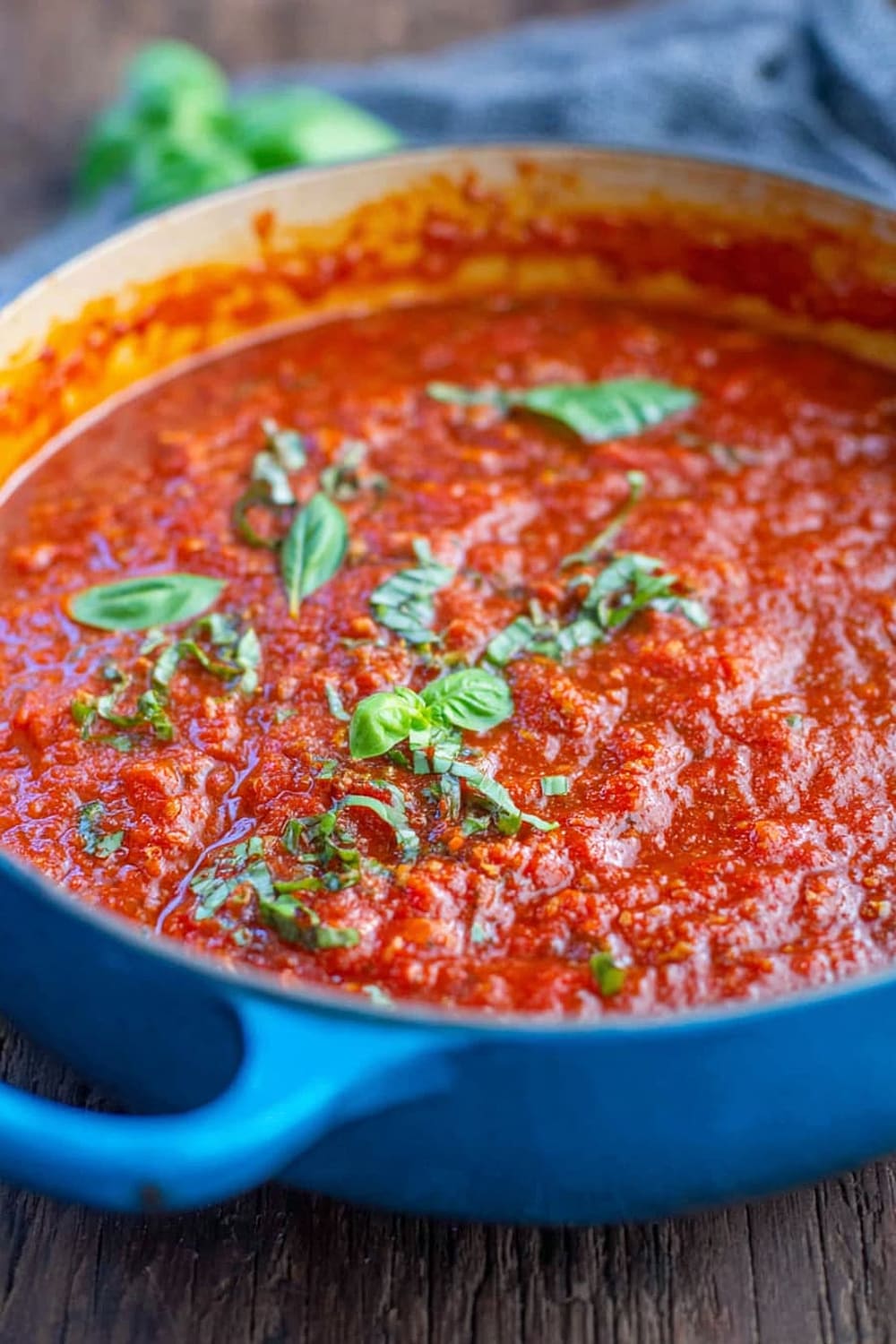
Ingredients
For the Sauce Base
- 1 /4 cup extra virgin olive oil (Private Reserve Greek extra virgin olive oil recommended)
- 1 medium yellow onion, grated
- 3 garlic cloves, finely minced
- 2 carrots, finely grated (use a food processor or microplane grater)
For the Tomato Base
- 28 oz canned crushed tomatoes
- 1 /2 cup water (pasta cooking water preferred)
- Kosher salt and black pepper to taste
For the Seasoning
- 1 tbsp dried oregano
- 1 tsp sweet Spanish paprika
- Pinch red pepper flakes (optional)
- 1 /2 cup fresh basil, packed and torn
- 1 /2 cup fresh parsley, packed and chopped
To Serve
- 3 /4 to 1 lb cooked pasta of your choice
Instructions
Prepare the Aromatic Base
- 1 Heat the extra virgin olive oil in a large cast iron skillet or heavy-bottomed pan over medium heat until it just begins to shimmer, about 2-3 minutes. The oil should move freely but not smoke – this ensures maximum flavor extraction from your aromatics.
- 2 Add the grated onions, minced garlic, and finely grated carrots to the shimmering oil. Cook for 5 minutes, stirring regularly with a wooden spoon to prevent sticking. The vegetables should become fragrant and softened, with the onions turning translucent and the carrots beginning to break down.
Build the Sauce
- 3 Pour in the crushed tomatoes and 1/2 cup water (preferably reserved pasta cooking water for extra starch and flavor). Add a generous pinch of kosher salt and black pepper – start with about 1 teaspoon salt and 1/2 teaspoon pepper.
- 4 Stir in the dried oregano, sweet Spanish paprika, and red pepper flakes if using. The paprika adds a subtle smokiness that elevates the entire sauce. Finally, fold in the torn fresh basil and chopped fresh parsley, reserving a small handful of basil for finishing.
Simmer to Perfection
- 5 Bring the sauce to a rolling boil over medium-high heat, then immediately reduce heat to low. Cover the pan and let simmer for 15-20 minutes. Check halfway through – if the sauce appears too thick, add an additional 2-4 tablespoons of pasta water or regular water.
- 6 When the sauce has reached your desired consistency and the flavors have melded beautifully, taste and adjust seasoning. Add the remaining fresh basil if desired. The sauce should coat the back of a spoon and have a rich, deep red color.
Finish and Serve
- 7 If serving immediately, add your cooked pasta directly to the sauce. Toss to combine using tongs or a pasta fork, allowing the pasta to cook in the sauce over low heat for 5 minutes. This crucial step helps the sauce cling to every strand of pasta, creating that perfect restaurant-style coating.
Recommended Equipment and Kitchen Tools
Essential Tools (for best results)
- Large cast iron skillet or heavy-bottomed pan – provides even heat distribution and prevents scorching while building deep flavors in your sauce base
- Food processor with grating attachment – makes quick work of finely grating carrots and onions to the perfect consistency for melting into the sauce
- Microplane grater – ideal for achieving restaurant-quality minced garlic and finely grated vegetables that integrate seamlessly
- Wooden spoon or silicone spatula – won’t scratch your cookware and allows for gentle stirring without breaking down the tomatoes too much
Helpful Upgrades
- Kitchen scale – for precise measurements when scaling the recipe up for meal prep or batch cooking
- Immersion blender – if you prefer a completely smooth sauce, pulse briefly right in the pan
- Fine-mesh strainer – for removing seeds if using whole tomatoes instead of crushed
Nice-to-Have Options
- Pasta serving bowls that retain heat – keeps your perfectly sauced pasta warm during family-style serving
- Airtight storage containers – this sauce freezes beautifully for make-ahead meal prep
Recipe Variations and Dietary Modifications
Gluten-Free Adaptation
- This sauce is naturally gluten-free – simply serve over gluten-free pasta, zucchini noodles, or spaghetti squash
- For thickening, use cornstarch slurry instead of flour-based roux if needed
- Ensure your pasta cooking water comes from certified gluten-free pasta
Vegan Modifications
- Recipe is already completely plant-based and vegan-friendly
- Enhance umami depth by adding 1 tablespoon nutritional yeast during simmering
- Include 1 teaspoon balsamic vinegar for additional complexity
Low-Carb/Keto Version
- Serve over spiralized zucchini, shirataki noodles, or spaghetti squash
- The sauce itself contains approximately 8g net carbs per serving
- Add 2 tablespoons tomato paste instead of extra water for richer flavor without additional carbs
Protein-Enhanced Variations
- Brown 1 lb ground turkey or lean beef before adding vegetables for a hearty meat sauce
- Fold in 1 cup cooked lentils during the last 5 minutes for plant-based protein
- Add 1/2 cup chopped sun-dried tomatoes for concentrated flavor and texture
Flavor Variations
- Mediterranean twist: Add 2 tablespoons capers and 1/4 cup sliced Kalamata olives
- Spicy version: Double the red pepper flakes and add 1 diced jalapeño with the aromatics
- Garden fresh: Fold in 1 cup diced zucchini and 1/2 cup corn kernels during simmering
Nutritional Information and Health Benefits
Key Nutritional Highlights
Each serving of this homemade sauce (without pasta) contains approximately 95 calories, with 6g healthy fats from the extra virgin olive oil, 8g carbohydrates primarily from the tomatoes and vegetables, and 3g fiber. The sauce provides significant amounts of vitamin C from the tomatoes and fresh herbs, vitamin A from the carrots, and potassium essential for heart health.
Health Benefits of Main Ingredients
The crushed tomatoes are rich in lycopene, a powerful antioxidant that becomes more bioavailable when cooked with olive oil, potentially supporting heart health and reducing inflammation. Fresh basil contains compounds like eugenol that have anti-inflammatory properties, while garlic provides allicin, known for its immune-supporting benefits. The grated carrots add natural sweetness while contributing beta-carotene, which converts to vitamin A for eye health and immune function.
Dietary Considerations
This sauce is naturally dairy-free, gluten-free, vegan, and low in sodium (you control the salt content). It’s also rich in antioxidants from the combination of tomatoes, herbs, and olive oil. The fiber content from the vegetables helps with satiety and digestive health, making this a nutrient-dense addition to any meal plan.
Smart Swaps and Ingredient Substitutions
Common Substitutions:
- Extra virgin olive oil → Avocado oil or grapeseed oil (use same amount, slightly less flavor)
- Fresh basil → 1 tablespoon dried basil (add with other dried herbs, not at the end)
- Fresh parsley → 1 tablespoon dried parsley or fresh cilantro for different flavor profile
- Crushed tomatoes → 28 oz whole tomatoes, crushed by hand for more texture
Budget-Friendly Swaps:
- Private Reserve olive oil → Any good quality extra virgin olive oil from your pantry
- Fresh herbs → Dried herbs using 1:3 ratio (1 tsp dried = 1 tbsp fresh)
- Organic vegetables → Conventional produce works perfectly fine for this recipe
Pantry Emergency Substitutions:
- Yellow onion → White onion, shallots, or even 2 tbsp onion powder in a pinch
- Fresh garlic → 1 teaspoon garlic powder (add with dried herbs, not at beginning)
- Carrots → 1 tablespoon tomato paste for sweetness, or finely diced bell pepper
Pro Tips for Substitutions:
- When using dried herbs instead of fresh, add them early with the tomatoes to allow rehydration
- Store leftover fresh herbs in ice cube trays with olive oil for future sauce-making
- Pasta cooking water can be replaced with vegetable broth for extra flavor depth
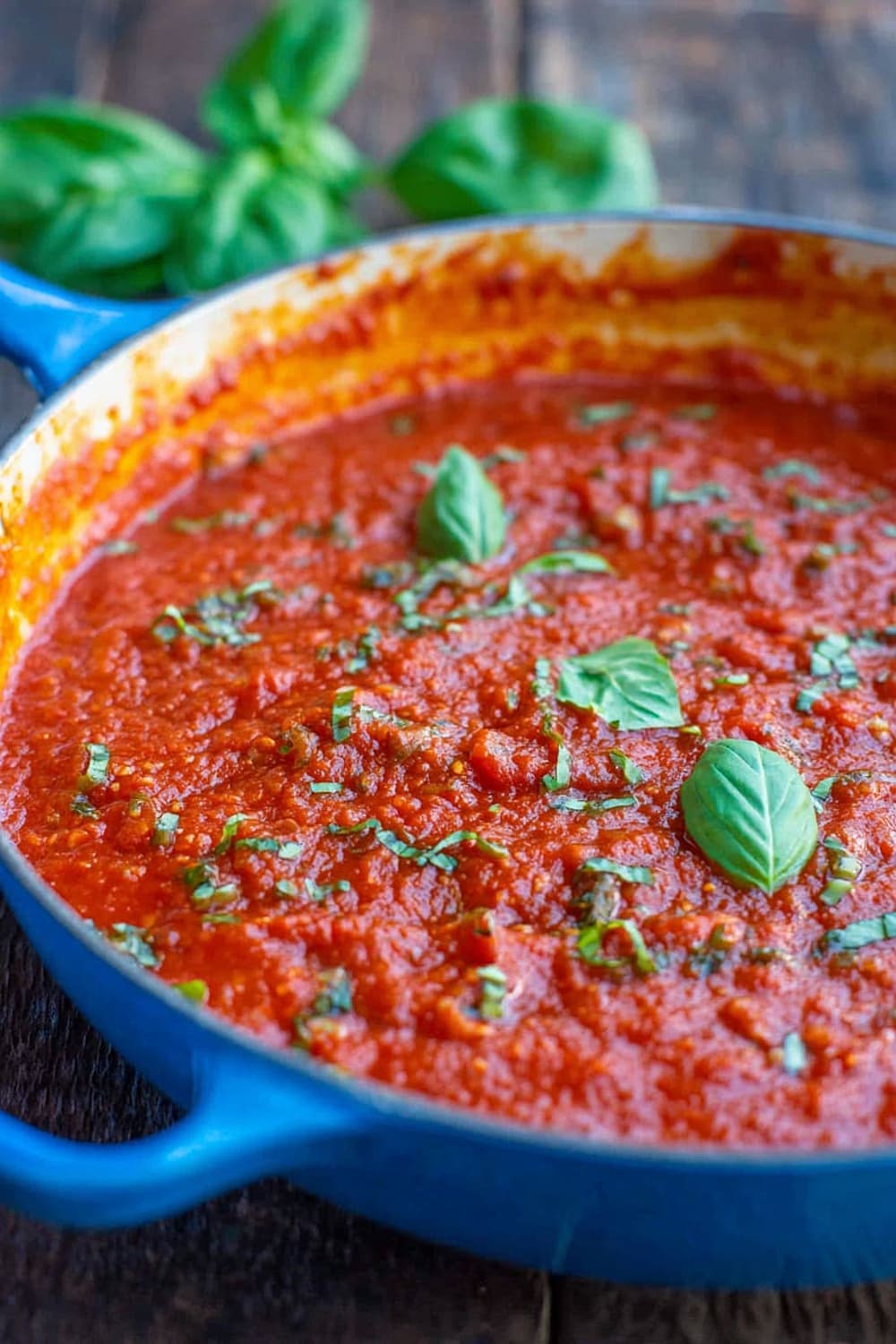
Make It Diabetes-Friendly
Natural Sugar Content:
- This recipe relies on natural vegetable sugars from carrots and tomatoes rather than added sugars
- Each serving contains approximately 6g natural carbohydrates from vegetables
- The fiber content helps slow sugar absorption and maintain stable blood glucose
Portion & Pairing Tips:
- Recommended serving: 1/2 cup sauce with 1/2 cup cooked whole grain pasta
- Estimated carbs per serving: 8g from sauce, 15g from 1/2 cup pasta
- Pair with protein: Add grilled chicken, turkey meatballs, or white beans to balance the meal
- Add healthy fats: The olive oil content helps slow carbohydrate absorption
Blood Sugar-Friendly Modifications:
- Serve over zucchini noodles or shirataki noodles to reduce carb content to under 10g total
- Add extra fiber with 1/4 cup ground flaxseed stirred into sauce
- Include protein directly in the sauce with lean ground turkey or lentils
Total Carb Reduction: Using vegetable noodles instead of pasta reduces total meal carbs from 23g to under 10g per serving.
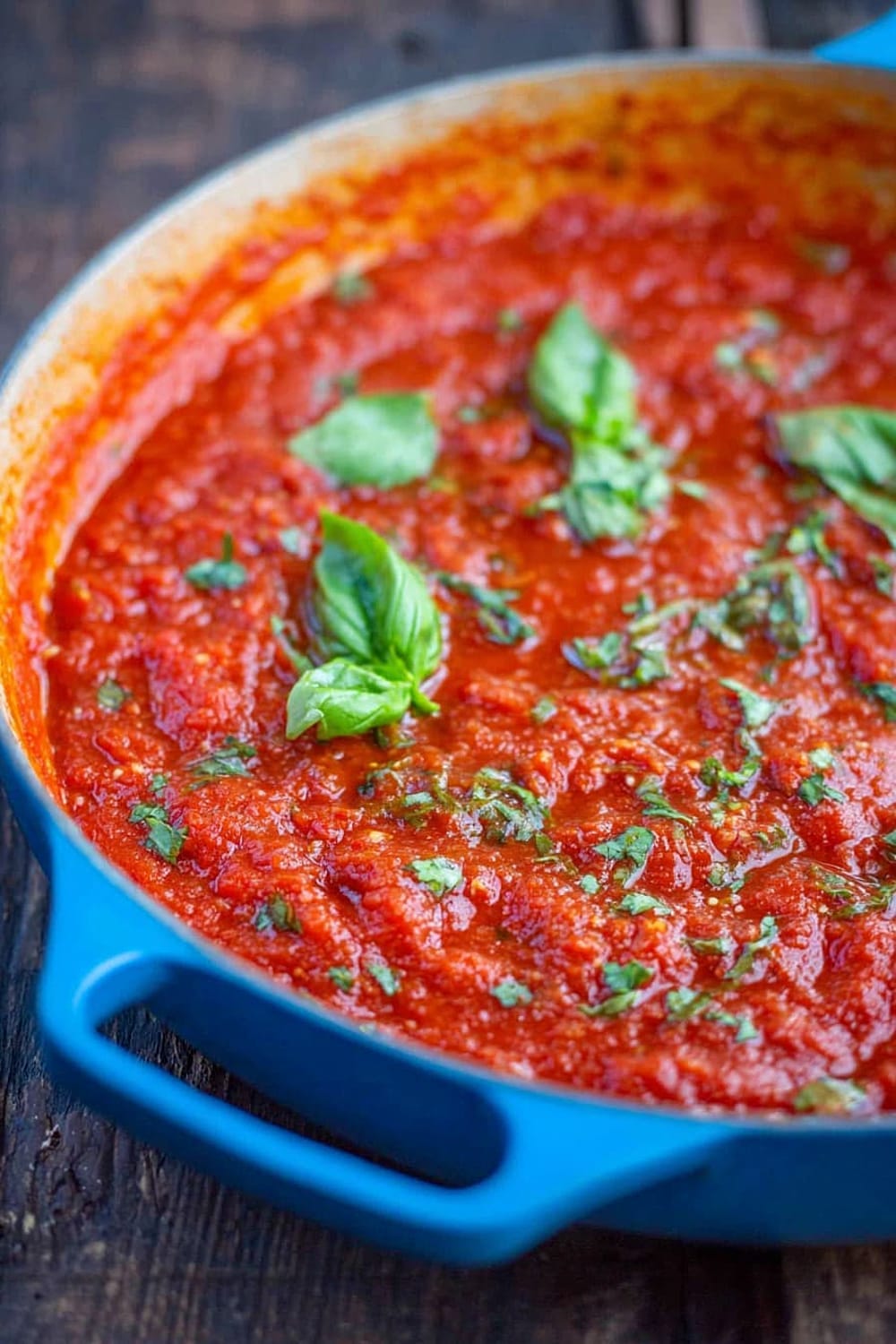
Perfect Pairing Suggestions
Beverage Pairings
This robust tomato sauce pairs beautifully with medium-bodied red wines like Chianti or Sangiovese, whose acidity complements the tomatoes without overwhelming the fresh herbs. For non-alcoholic options, try sparkling water with lemon or unsweetened iced tea with fresh basil to cleanse the palate between bites. Italian sodas like San Pellegrino Aranciata provide a festive touch for family dinners.
Side Dish Recommendations
Serve alongside garlic bread made with crusty Italian bread and extra virgin olive oil, or prepare a simple arugula salad dressed with lemon vinaigrette to cut through the sauce’s richness. Roasted vegetables like zucchini, bell peppers, or eggplant echo the Mediterranean flavors, while steamed broccoli adds color and nutrition. A caprese salad with fresh mozzarella, tomatoes, and basil creates a cohesive Italian theme.
Complete Meal Ideas
Build a full Italian feast by starting with bruschetta topped with diced tomatoes and basil, followed by pasta with this sauce, and finish with tiramisu or panna cotta. For casual family dinners, pair with Caesar salad and breadsticks. During entertaining, serve family-style with multiple pasta shapes, grated Parmesan, and Italian meatballs or grilled sausages.
Occasion Suggestions
Perfect for Sunday family dinners, meal prep sessions, or casual entertaining. The sauce freezes beautifully, making it ideal for busy weeknight solutions or batch cooking adventures.
Pro Tips and Troubleshooting
Professional Techniques
Always grate your onions and carrots rather than dicing – this allows them to completely dissolve into the sauce, creating natural sweetness without obvious vegetable chunks. Save pasta cooking water before draining; its starch content helps bind the sauce to pasta better than plain water. Taste and adjust seasoning at the end – tomato acidity can vary significantly between brands, so your sauce might need extra salt or a pinch of sugar.
Common Mistake Prevention
Never skip the initial sautéing of aromatics – this builds the flavor foundation that makes homemade sauce superior to jarred versions. Don’t rush the simmering process; 15-20 minutes allows flavors to meld and concentrate properly. Avoid over-stirring once tomatoes are added, which can break them down too much and create a mushy texture.
Storage and Make-Ahead
This sauce improves overnight in the refrigerator as flavors continue developing. Store covered for up to 5 days refrigerated or 3 months frozen in portion-sized containers. For meal prep, make double batches and freeze in ice cube trays, then transfer to freezer bags for individual servings. Reheat gently over low heat, adding pasta water if needed to restore consistency.
Scaling Success
When doubling the recipe, use a larger pan to prevent overcrowding and ensure proper evaporation. Triple recipes work best when made in batches to maintain quality. For single servings, this recipe scales down perfectly – just use a smaller saucepan and reduce cooking times slightly.
This homemade spaghetti sauce proves that the best comfort food comes from your own kitchen, not a jar. With its perfect balance of fresh herbs, aromatic vegetables, and rich tomatoes, you’ll never want to go back to store-bought sauce again.